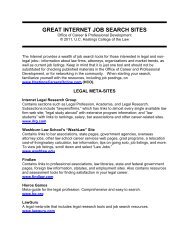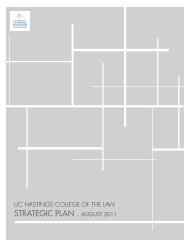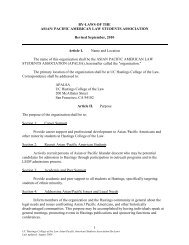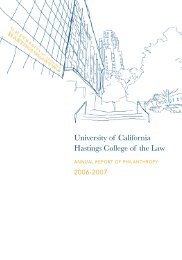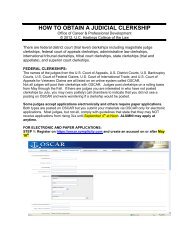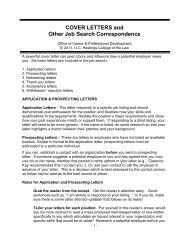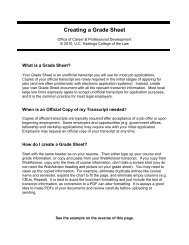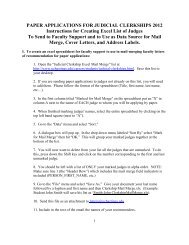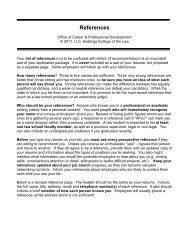Class 8 Concurrent Estates
Class 8 Concurrent Estates
Class 8 Concurrent Estates
You also want an ePaper? Increase the reach of your titles
YUMPU automatically turns print PDFs into web optimized ePapers that Google loves.
PROPERTY<br />
<strong>Concurrent</strong> estates<br />
© Professor Joan C. Williams<br />
Spring 2013
RAP REVIEW
Name the estates created<br />
In Jan. 1, 2000, “To A for life, then to A’s first<br />
child to reach the age of 25.” A has two kids<br />
• A –life estate<br />
• A’s first child – contingent remainder in fee<br />
• O –reversion<br />
Now apply RAP
(1/1/2000) A, A’s first child to each<br />
25, and all humanity
(12/30/2000) Child of A born after the<br />
grant
12/31/2000 Everyone alive at<br />
the time of the grant dies
RAP<br />
• SO…Afterborn will reach the age of 25 in<br />
2025, more than 21 years after all lives in<br />
being plus 21<br />
• Grant to him violates RAP
So…. After RAP<br />
• “To A for life, then to A’s first child to reach<br />
the age of 25.”<br />
– A – life estate<br />
– A’s first child – contingent remainder in fee<br />
-- O reversion<br />
AFTER APPLICATION OF RAP<br />
-A has a life estate<br />
-O has a reversion
Name the estates created<br />
In Jan. 1, 2000, “To A for life, then to A’s widow for<br />
life, then to A’s surviving children.” A is married to<br />
Jane, and has three kids<br />
• A –life estate<br />
• A’s widow – remainder in a life estate<br />
• A’s surviving child – contingent remainder in fee<br />
• O –reversion<br />
• A<br />
Now apply RAP
(1/1/2000) Time of the grant
Alas….<br />
Jane dies a few<br />
months later
(1/1/2020) A marries afterborn, Sue, who has a child
1/2/2020 Everyone alive at<br />
the time of the grant dies
What now?<br />
• She has her life estate<br />
– She could live on for another 30 years, dying<br />
in 2050.<br />
• Kids’ interest violates RAP<br />
– Because if Sue did live that long, their interest<br />
would vest later than lives in being (everyone<br />
alive at the time of the grant died in 2020)<br />
plus 21 years
Hensley-O’Neal v. Metropolitan<br />
• Option<br />
• Pre-emptive right
CONCURRENT ESTATES
Locke revisited<br />
• Think back to nature narrative: acorns in the wild<br />
• Presumption that property will be individually<br />
owned<br />
• Is most property in the U.S. individually owned?<br />
• No<br />
• Corporations<br />
• Partnerships<br />
• Houses owned by couples<br />
• Natural resource leases<br />
• Intellectual property
Types of concurrent estates:<br />
general categories<br />
• Joint tenancy and tenancy in common<br />
– What is the difference?<br />
• Joint tenancy = 4 unities: time, title, interest, possession<br />
– Links 2 characteristics that are logically independent<br />
• Tenancy in common<br />
– Default category: why did the default category shift over time?<br />
• Tenancy by the entirety<br />
– Fifth requirement<br />
– Presumption<br />
– Cannot sever or partition without consent of other<br />
– Purpose?
Advantages of the joint tenancy<br />
• Poor man’s will<br />
– Avoids probate, reduces administrative costs<br />
and publicity<br />
• Preferential state tax treatment<br />
• Symbolism in marriage<br />
• Sometimes free from claims of creditor of<br />
other spouse<br />
• Avoids fragmentation of property
“We are joint together…”<br />
• What kind of estate did each lottery winner<br />
win?<br />
• “To A, then to the children of B.” B has 3<br />
children<br />
• What estate do the children of B get?
In California, for spouses/<br />
domestic partners<br />
• Tenancy by entirety abolished in Calif.<br />
– Community property<br />
– Community property with right of survivorship<br />
• What’s the difference?<br />
• Functional equivalent to tenancy by the entirety<br />
– Co-owner cannot sever or alienate without partner’s<br />
agreement<br />
– Presumption of community property if owners are<br />
married couple
Problem<br />
• Bill and Cindy are buying a house<br />
together. She asks you how they should<br />
take title. Interview her to get the<br />
information you need to make a<br />
recommendation.
Problem<br />
• Your client, Sue, who is a lesbian, consults<br />
you to plan her estate. She wants to leave<br />
all of her property to her life partner, Jill.<br />
Their state prohibits gay marriage.<br />
Recommend an estate plan.
Problems<br />
• “To A and B jointly.”<br />
• Sufficient to overcome presumption in<br />
favor of TIC?<br />
• “To A and B as JT with right of<br />
survivorship and not as TIC.”<br />
• Joint tenancy in every state, in every<br />
context
Problems<br />
• “To A, a 1/3 undivided interest, and B, and<br />
2/3 undivided interest, as JT.”<br />
• Is it a joint tenancy?<br />
– Time<br />
– Title<br />
– Interest<br />
– Possession
Problems<br />
• “A and B are TIC with equal shares. A<br />
dies intestate, leaving equal shares to X, Y<br />
and Z.” Who owns what?<br />
A + B as TIC<br />
/ | \ 1/2<br />
| | |<br />
X Y Z<br />
1/6 1/6 1/6
Problems<br />
• “A and B are JT with equal shares. A dies<br />
intestate, leaving equal shares to X, Y and<br />
Z.”<br />
• B owns it all
Problems<br />
• A, B and C are JT. A conveys his interest to X.<br />
A dies intestate, leaving an heir, AH. How is title<br />
now held?<br />
• B and C are JT (2/3); TIC with X (1/3).<br />
• Then X dies intestate, leaving an heir, XH.<br />
• B and C are JT (2/3); TIC with XH (1/3).<br />
• B then dies intestate, leaving an heir, BH.<br />
• XH (1/3) is TIC with C (2/3).<br />
• C then dies intestate, leaving an heir, CH.<br />
• XH (1/3) is TIC with CH (2/3).
DV<br />
• Husband murders wife after she moves<br />
into a shelter with their kids.<br />
• House=JT<br />
• H conveys house to his attorney<br />
• Kids’ guardian sues
Arguments<br />
• For wife<br />
• Severance<br />
• Public policy<br />
• Barred from profiting<br />
• Domestic violence<br />
• Legal fiction<br />
• For husband<br />
• Not profiting from his<br />
crime: he had full<br />
legal ownership<br />
before the crime<br />
• No forfeiture of<br />
estates<br />
• He’s paying his debt
Uniform Simultaneous Death Act<br />
• Where there is no sufficient evidence that<br />
two joint tenants…have died otherwise<br />
than simultaneously, the property so held<br />
shall be distributed one half as if one had<br />
survived and one half as if the other had<br />
survived….
Alma Soul<br />
• What’s going on here?
Non-marital “divorce”<br />
• Quasi-marital relationship (“palimony”)<br />
• Presumption can be overcome by<br />
– Oral contract<br />
– Implied contract<br />
– Breach of fiduciary relationship



